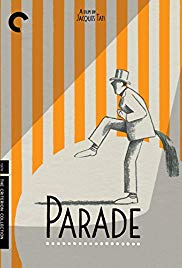
PARADE
France, 1974, 85 minutes, Colour.
Jacques Tati.
Directed by Jacques Tati.,
Parade is the last film by renowned comedian and mime, Jacques Tati. While he appeared in some films early in his career, including a number of short films, he made his main impact in the late 1940s with Jour de Fete which was followed by the classics Mon Oncle, Playtime, Traffic.
This is a film version of an elaborate circus performance at the Tennis Centre, Roland Garros, in Paris.
The early sequences show the range of crowds coming in for the performance, some in costume, old and young, with a focus on a little girl and her mother and a little boy sitting next to his father. They become involved in the action throughout the performance.
As the show warms up, the audience in the cinema audience become more and more involved with the range of acts. All the time throughout the show, workers, in workers’ clothes and overalls, are continually preparing the props for the performance, huge signs, artistic devices, spray-painting balls, a great deal of movement. In fact, many of these artists are very skilled in their performances. There is a piano which is turned on its side and becomes a horse for jumping over, members of the cast in all kinds of different costumes, including orchestral, military, interspersing the action with their awkward leaping over the horse.
There are some amusing music magician sequences, one of the workers being more skilled than the official magician – and an intervention from a member of the audience.
There are a great number of musicians, orchestral pieces, clowns coming on and playing with different instruments, singer Pia Colombo also appearing and singing. And there are some disputes and slapstick between members of the orchestra. There are also Russian dancers as well as flamenco performers.
There is an elaborate pony sequence where members of the audience try to ride the pony and, in slapstick fashion, fail. There is a balding bespectacled older gentleman from the audience who continues to try. Ultimately, it is the little boy who is sometimes bored, sometimes involved, who is successful.
The juggling is quite outstanding, a woman and two men juggling feather dusters in a great number of combinations including each standing on the other shoulders, juggling the dusters which hit the wall in painted patterns.
However, the star of the whole show is, of course, Jacques Tati. And, once again, his mimes are brilliant and audiences will be glad of the opportunity to see them, miming tennis, miming boxing, miming equestrian performance, miming police in London and Paris, miming fishing… If these pieces were edited together they would be a fine final tribute to Tati and his skills.
The film ends with everybody leaving, the little girl and the little boy playing on the stage, in the wings, and finally with their parents.